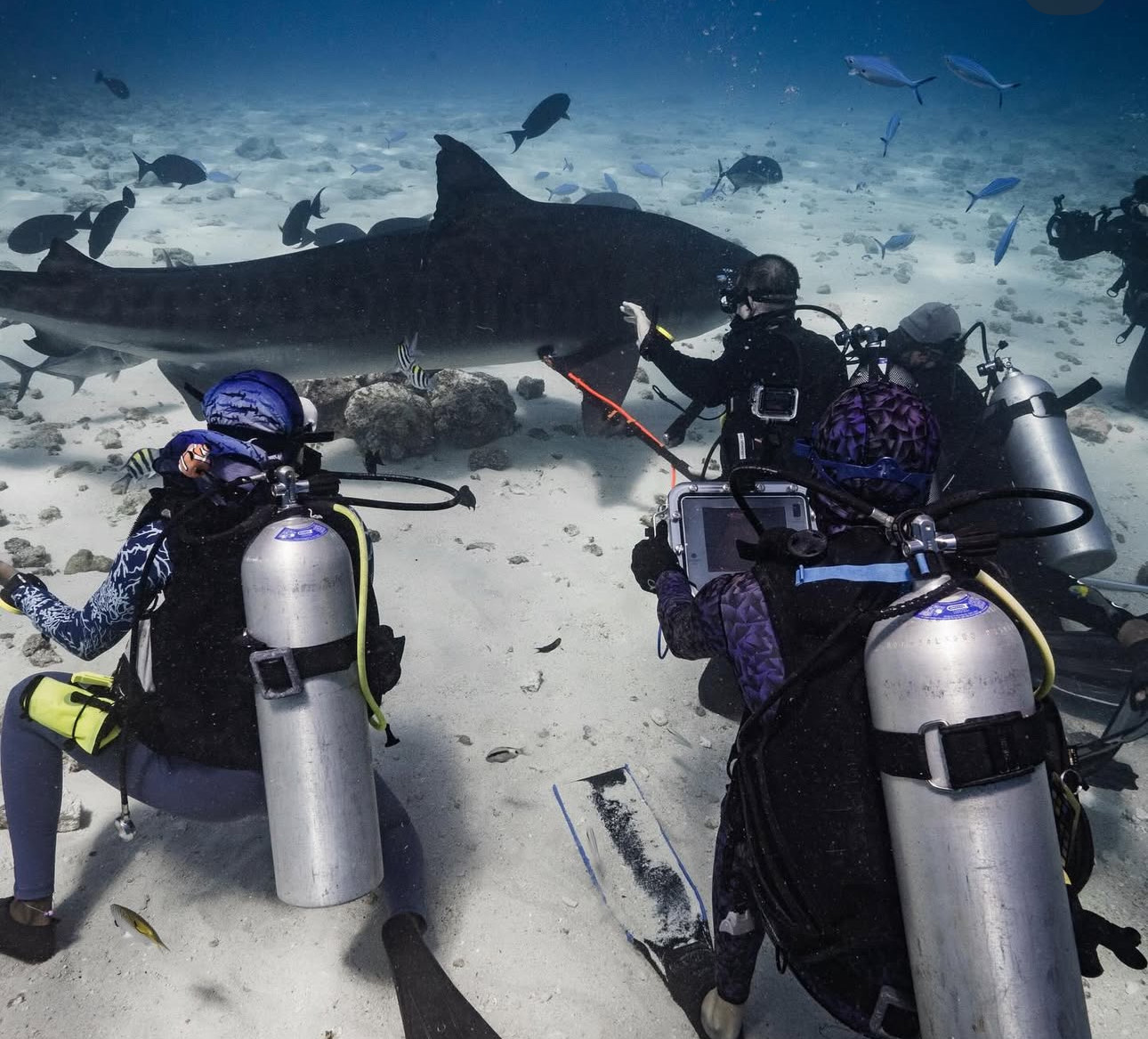Momma Tiger Shark Project in Fuvahmulah
Beneath the deep blue waters of Fuvahmulah’s Tiger Harbor hides an amazing discovery: a safe haven where powerful tiger sharks (Galeocerdo cuvier) reveal their gentler side. For up to 16 months, female tiger sharks carry their babies within them, turning their strong bodies into living nurseries in the warm waters of the Indian Ocean. This incredibly long pregnancy remained mostly unknown until local dive guides started noticing unusual patterns they couldn’t ignore. It struck our curiosity.
Tiger Harbor wasn’t just a place where sharks came to feed or pass through, but something much more special: a pregnancy sanctuary where these impressive creatures gather during their most vulnerable time. It sparked a variety of questions, like: What makes these magnificent sharks choose these particular waters? What ancient instinct guides them to this specific Maldivian island?
Simple curiosity grew into a passionate pursuit in May 2024. Our researchers began an innovative project where we partnered with a competitor dive center to investigate tiger shark pregnancy patterns in Fuvahmulah. The initiative leveraged the expertise of the marine biologists from our two different dive centers, who collaborated together to ultrasonically examine free-swimming sharks. This effort built upon previous work dating back to 2016/2017, during which our teams had been meticulously identifying and photographing individual tiger sharks in Fuvahmulah’s waters.
The primary goal of the project, fondly referred to as the ‘Momma Tiger Project’, was to obtain concrete scientific evidence of pregnancy among the tiger sharks frequenting the island’s waters. The research team was particularly interested in determining how many pregnant sharks were present around the island, regardless of their gestation stage.
Intrigued to learn what we discovered? Read on.
Key Findings of the Momma Tiger Project
The research was conducted by a team led by James A. Sulikowski from Oregon State University, in collaboration with several NGOs including Fuvahmulah Dream, Miyaru Shark Programme, and Nature Friends of Maldives. Fieldwork and previous tiger shark identification data were provided to the team by Fuvahmulah Dive School and Pelagic Divers Fuvahmulah.
Researchers deployed a high-definition submersible ultrasound called an IBEX Aquanaut with a 60mm curved transducer to scan sharks as they swam by, capturing images of developing embryos inside the mothers as they swam freely through the waters of Tiger Harbor. The results were remarkable, revealing that an overwhelming 93% of the adult female sharks were pregnant examined — 26 out of the 28 scanned.
Interestingly, the team identified two distinct groups of embryos within these mother sharks: one group with embryos averaging just 8.0 cm in total length, and another with significantly larger embryos measuring about 18.4 cm. This size difference suggests either staggered breeding periods or varying growth rates among developing shark pups.
Adding to the intrigue of this discovery was the complete absence of male tiger sharks throughout the entire study period, which ran from May 2 to May 12, 2024, further supporting the theory that this location serves as a specialized sanctuary for pregnant females.
Significance of Our Pregnant Tiger Sharks Project
The unprecedented pregnancy rate documented at Tiger Harbor — the highest ever recorded for tiger sharks! — provides compelling evidence that this site functions specifically as a dedicated gestation ground. This discovery challenges existing scientific understanding of tiger shark reproduction, suggesting these magnificent predators may reproduce on a biennial or possibly even annual cycle, rather than the previously accepted triennial pattern.
Environmental factors also likely play a crucial role in this reproductive haven. The consistently warm, calm waters of Tiger Harbor may create ideal conditions that accelerate embryonic development, potentially shortening the typically lengthy gestation period of tiger sharks (which is 13-16 months). Additionally, the location offers practical advantages for pregnant females, with the nearby tuna fishery providing a consistent, low-effort food source — a significant benefit for sharks carrying developing young. Together, these factors create a perfect nursery environment that explains why so many pregnant tiger sharks congregate in this specific location.
Conservation Efforts Moving Forward
This research shows how important dive tourism is for learning about sharks. Divers and researchers working together at Fuvahmulah discovered things about shark reproduction that scientists might never have found otherwise. The timing of this discovery is crucial because there were plans to allow commercial fishing with long-lines in Maldivian waters. These fishing methods could seriously harm any tiger shark nursery that could potentially be in nearby waters.
To protect these pregnant sharks, the researchers strongly advocate for a complete ban on fishing in this area year-round. Pregnant tiger sharks are especially vulnerable during this time and need this protection. This study also shows how innovative technologies like underwater ultrasound can help us learn about sharks without hurting them. Instead of catching or killing sharks to study them, researchers can now gather important information while leaving the sharks unharmed in their natural habitat. This approach could change how we study and protect not just sharks, but many other marine species worldwide.
If this has sparked an interest in you and you wish to dive and swim with tiger sharks in Fuvahmulah, reach out to our passionate team here or peruse our offerings here. We offer more than just diving trips – we provide a genuine experience with knowledgeable guides who care deeply about these animals. During your visit, we’ll show you the best ways to dive with sharks while treating them with respect. You’ll also learn how your tourism choices can help protect the ocean. Get in touch with us to plan your adventure and join our efforts to safeguard these magnificent creatures.

